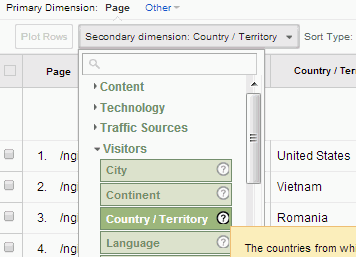Maximize Your Reporting with Secondary Dimension in Google Analytics
Maximize Your Reporting with Secondary Dimension in Google Analytics
Blog Article
Optimize Coverage Precision With Additional Measurement in Google Analytics
Recognizing exactly how to make the most of reporting precision with secondary dimensions in Google Analytics can significantly improve the deepness of insights stemmed from information analysis. By integrating second dimensions strategically, marketing experts can discover surprise patterns and correlations that might not be instantly evident when examining main metrics alone. This nuanced strategy enables an extra detailed understanding of individual actions and campaign performance, leading the means for even more targeted and reliable decision-making. The utilization of additional measurements holds the vital to unlocking a riches of beneficial information that can transform the effectiveness of digital marketing approaches.
Understanding Secondary Measurements in Google Analytics
To boost information evaluation and gain deeper understandings right into individual behavior, understanding secondary measurements in Google Analytics is essential. Second measurements permit individuals to segment and further study data beyond the primary measurement chosen. By integrating secondary dimensions, analysts can refine their records to expose more thorough details regarding customer interactions on a site. As an example, while the primary measurement may show the overall number of web page views, adding a second measurement such as 'source/medium' can give insights right into where the web traffic originated from. This extra layer of info makes it possible for online marketers to evaluate the effectiveness of various advertising campaigns or channels in driving website traffic to the site.
Furthermore, recognizing secondary measurements is important for developing a lot more customized reports customized to details business goals. By picking the best mix of key and secondary dimensions, analysts can discover patterns, fads, and correlations that may otherwise stay concealed. This nuanced approach to information evaluation empowers businesses to make informed choices based on a thorough understanding of individual habits throughout numerous measurements.

Exactly How to Use Second Measurements
When leveraging second dimensions in Google Analytics, the functional application includes selecting details information specifications to further fine-tune insights past the primary measurement's range. To apply second measurements efficiently, begin by accessing the report or dataset where you desire to dive deeper right into the data. Remember that second measurements help give context and granularity to your main dimension information, allowing you to extract even more workable and meaningful understandings from your Google Analytics reports.
Leveraging Additional Dimensions for Insights
Making use of additional measurements in Google Analytics enables for an extra thorough evaluation of information, using valuable insights past the primary measurement's scope. By leveraging second dimensions, customers can dive much deeper into the efficiency metrics of their website or app, uncovering click this covert patterns and fads that may not be instantly evident when only checking out primary dimensions.
One key benefit of utilizing second dimensions is the ability to segment and filter data more exactly. This can assist online marketers and experts better understand the habits of details customer sectors, such as brand-new visitors versus returning site visitors, or web traffic coming from different geographic places.
Furthermore, additional measurements allow individuals to contrast and comparison different data points within the same report, providing a more holistic view of performance (Secondary Dimension in Google Analytics). For instance, pairing the key measurement of touchdown web pages with additional dimensions like gadgets or demographics can reveal which pages are most effective in engaging customers on various gadgets or from various market groups.
In essence, leveraging secondary measurements in Google Analytics equips users to draw out richer insights from their information, resulting in even more educated decision-making and eventually, improved efficiency.
Best Practices for Additional Dimensions
When evaluating information in Google Analytics, including additional dimensions effectively improves the deepness of understandings derived from the primary metrics. To make one of the most out of secondary measurements, it is crucial to sites adhere to ideal methods that ensure purposeful and precise coverage. It is crucial to select additional measurements that straighten with the main metric you are examining. Choosing appropriate second dimensions assists in giving context and a clearer understanding of the information being analyzed.
Additionally, it is advised to restrict the number of additional measurements used in a solitary record to prevent frustrating the analysis with excessive information. Concentrating on a couple of essential second measurements at a time can result in even more actionable and focused understandings. In addition, consider trying out various combinations of second and key measurements to reveal distinct patterns and patterns that might not be apparent when taking a look at the data alone.
Advanced Analysis Techniques With Additional Measurements
Checking out elaborate information partnerships with the strategic application of second measurements can introduce nuanced understandings that elevate the deepness of analysis in Google Analytics. By incorporating secondary measurements with key information sets, innovative evaluation techniques can be used to extract beneficial info.
Furthermore, additional dimensions can enhance the evaluation of conversion paths by giving additional context. Recognizing the different touchpoints a customer communicates with prior to converting can be crucial in enhancing the customer journey - Secondary Dimension in Google Analytics. By making use of secondary dimensions to explore specifics such as traffic resources or tools utilized, marketing experts can tailor approaches to target high-converting channels properly
Conclusion

To enhance information evaluation and gain deeper understandings right into user habits, recognizing additional dimensions in Google Analytics is crucial - Secondary Dimension in Google Analytics. Secondary dimensions allow users to sector and additionally dissect information past the primary measurement picked. While the primary measurement might display the total number of page views, including a second measurement such as 'source/medium' can provide insights right into where the traffic originated from.When leveraging additional dimensions in Google Analytics, the functional application includes picking details information criteria to more improve understandings past the main dimension's range. Keep in mind that additional dimensions help give context and granularity to your main measurement information, enabling you to draw out more purposeful and workable understandings from your Google Analytics records
Report this page